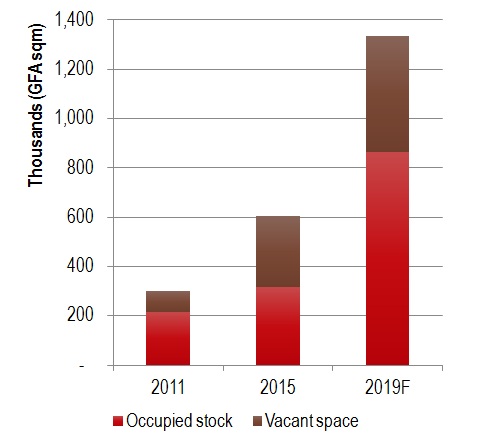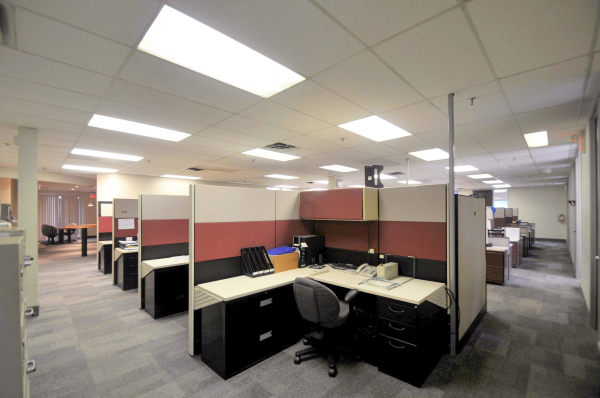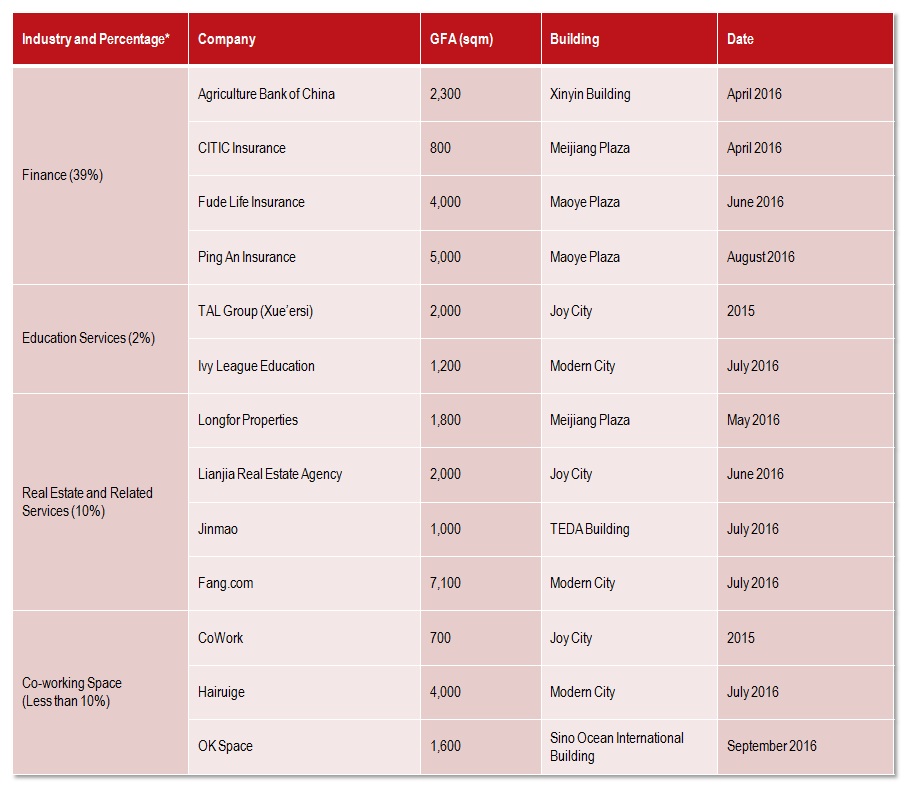Who will fill the void left by P2P tenants?
By Chelsea Cai, Head of Research at JLL Tianjin
 Anyone watching the Tianjin skyline is aware that the city has been adding new office buildings at a fast pace over the past decade. As we have mentioned in a previous article, "Strata-title: A danger worse than empty buildings," some landlords have opted to sell space floor-by-floor or even unit-by-unit in order to lessen their financial burden. However, many landlords remain intent on leasing their space in this increasingly competitive market. One challenge the landlords have is to determine which sector is going to provide the demand needed to lease out all this space? In 2014 and 2015, thanks to financial innovation, the emergence of a new industry - so called "peer-to-peer lending" or P2P - became a welcome driver of office demand. These companies were aggressively expanding throughout the city and leased much of the surplus space from new office completions, as explained in last year's publication, "Will Shadow Banks save China Developers?" However, after a number of P2P companies declared bankruptcy, the government has stepped in to limit the registration of new P2P companies, which has led to a major slowdown in office demand in Tianjin and many other Tier 2 cities.
Anyone watching the Tianjin skyline is aware that the city has been adding new office buildings at a fast pace over the past decade. As we have mentioned in a previous article, "Strata-title: A danger worse than empty buildings," some landlords have opted to sell space floor-by-floor or even unit-by-unit in order to lessen their financial burden. However, many landlords remain intent on leasing their space in this increasingly competitive market. One challenge the landlords have is to determine which sector is going to provide the demand needed to lease out all this space? In 2014 and 2015, thanks to financial innovation, the emergence of a new industry - so called "peer-to-peer lending" or P2P - became a welcome driver of office demand. These companies were aggressively expanding throughout the city and leased much of the surplus space from new office completions, as explained in last year's publication, "Will Shadow Banks save China Developers?" However, after a number of P2P companies declared bankruptcy, the government has stepped in to limit the registration of new P2P companies, which has led to a major slowdown in office demand in Tianjin and many other Tier 2 cities.
Chart 1: Tianjin Grade A Office Stock

Source: JLL Research, 2Q16
The good news is that several industries have emerged with significant office leasing demand. Although they may not completely fill the void left by the sudden exit of several P2P firms, they are still expected to play a role in supporting the office leasing market. Industries growing in importance include finance, education, real estate and co-working space as well as new start-ups such as "Internet Plus" firms.
 - Finance: The finance industry's contribution to Tianjin's GDP in 2015 rose RMB 158.8 billion, an increase of 9.6% y-o-y, only behind Beijing and Shanghai in China. Unlike the P2P companies, where demand has stagnated due to regulation, traditional financial institutions, including insurance, banking and securities firms, are considering expanding operations or relocating to the new, high-quality office towers. This is particularly true in the insurance industry, where employment increased 27.9% y-o-y in 2015 to 63,600 employees (accounting for 13% of the total employment increase). By end of August 2016, insurance companies contributed 8% of the leasing transactions in Tianjin. Over the next few years, finance companies are expected to grow their Tianjin or North China operations, thereby increasing this sector's impact on office market demand.
- Finance: The finance industry's contribution to Tianjin's GDP in 2015 rose RMB 158.8 billion, an increase of 9.6% y-o-y, only behind Beijing and Shanghai in China. Unlike the P2P companies, where demand has stagnated due to regulation, traditional financial institutions, including insurance, banking and securities firms, are considering expanding operations or relocating to the new, high-quality office towers. This is particularly true in the insurance industry, where employment increased 27.9% y-o-y in 2015 to 63,600 employees (accounting for 13% of the total employment increase). By end of August 2016, insurance companies contributed 8% of the leasing transactions in Tianjin. Over the next few years, finance companies are expected to grow their Tianjin or North China operations, thereby increasing this sector's impact on office market demand.
- Education services: Private educational providers are a growing domestic industry that is increasingly absorbing office space as an alternative to retail. This sector includes after-school tutoring, exam preparation for study abroad as well as training institutions. Middle-class Chinese parents are eager to give their children a high-quality education and this "education fever" has given rise to the after-school tutoring market starting with elementary-aged children and even rising up to students preparing for their college entrance examinations. According to a recent report from Technavio, a UK research company, the rise in economic conditions of middle-class families and the abolition of the one-child policy have led to an increase in expenditure for the education sector. It will not be a big surprise to see the top tutoring providers in China, such as New Oriental Education, TAL Education Group and EF Education First, aggressively expand their presence in several new office locations in Tianjin near residential communities or with convenient transport.
- Real estate and related service: The rapid growth in residential prices and the improved sales volumes have fuelled the boom in the China property market since March 2016. The spillover effect has moved from overheated Tier 1 cities such as Beijing and Shanghai to lower tier cities. Residential prices increased nearly 30% y-o-y in 2Q16. And one-third of raw land sold for more than the published reserve price in Tianjin. Not only real estate developers but also residential agencies are actively hiring staff and setting up new branches to serve better the robust demand from homebuyers. Therefore, more office space is needed to meet the demand of expanding real estate developers and agencies.

- Co-working space: Premier Li Keqiang called for "mass entrepreneurship", and across the country, local authorities have tried to create a dynamic start-up environment by offering financing incentives and building co-working space or incubators for early-stage start-ups or small and medium-sized enterprises that lack sufficient capital. In China, we expect several successful stories from start-up companies to become household names, such as Didi, the Chinese ride-sharing company, and Meituan-dianping, an online delivery service. Nevertheless, secondary cities still lag behind Tier 1 cities such as Beijing and Shenzhen in fostering this entrepreneurial spirit due to policy, talent and financing constraints. For Tianjin, building incubators and co-working space may help to absorb some vacant space given their large size space requirements (usually occupying one or two floors), but the co-working space itself may have trouble generating demand and may end up as empty, as many start-ups still prefer to be located in Beijing.
-Another source of leasing demand will come from the technology sector. The central government's strategic "Internet Plus" initiative will encourage more firms to invest in new technologies and collaborate with start-up firms offering integrated web-solutions.
Table 1: Notable leasing transactions in 2015 & 2016

*Percentage refers to sector contribution to total leasing transactions from January to August 2016. The rest contributors also include professional services, media and others.
Source: JLL Research, as of August 2016
Conclusion
Leasing demand was lower in 3Q16 than in previous quarters, but more diversified, drawing upon many sectors and as a result healthier, more sustainable, long-term market. From the landlords' perspective, this demand is inherently less risky, as it comes from a larger array of sectors and more sustainable industrial than P2P lending.
For tenants, the main implication is that they can expect the tenant-favourable market to continue, which is marked by high vacancy rates and landlords willing to offer lower rents in order to fill space.
---END---